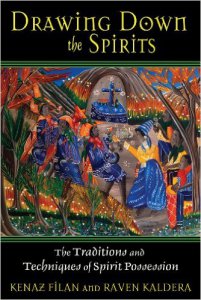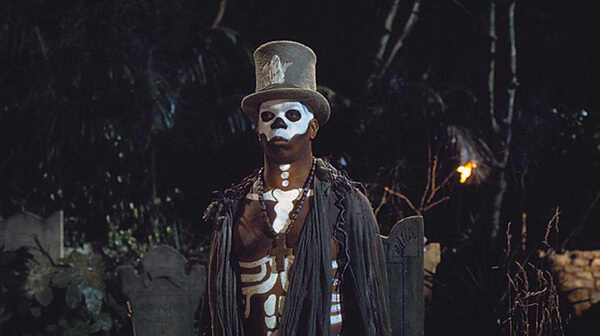 Drawing down the spirits, by Kenaz Filan and Raven Kaldera is an interesting book which shows much more than the practical techniques of “spirit possession.” It reveals a lot about modern paganism and its problems with mythic reality.
Drawing down the spirits, by Kenaz Filan and Raven Kaldera is an interesting book which shows much more than the practical techniques of “spirit possession.” It reveals a lot about modern paganism and its problems with mythic reality.
The book came recommended to me because I was interested in beefing up my system of working with what in the Western Mystery Tradition we call “contacts.” The writers come from the Haitian Tradition and the Northern Tradition which is much more hands on than many of the Western Mystery Tradition feels comfortable with.
The book is packed full of real, practical advice and techniques and explains the processes and above all the levels of spirit possession from the most basic god form work familiar to many in the Western Tradition, to Channelling (or contact work), to the full possession work called “horsing.” Horsing, most of the time, is when the person has their own consciousness switched off and is unaware of what is happening.
Fraud spirits
The book handles the issue of spirit frauds, either genuine or malefic rather well. Since I have seen both in play I feel it is a subject not particularly well handled in other books. Within my own tradition there is tendency to allow channellers to create unprovable fantastic worlds (normally in the channellers’ own past lives) which lead no-where and are expected to be taken literally. However, these people do believe in what they are doing. The person who channelled a dolphin spirit who claimed to be acting as spokespeople for aliens really did believe in what she was doing. Others, do it for the cash.
All this information made the book purchase valuable and necessary for anyone interested in this line of spirit research.
Smells like teen spirits
But what Filan and Kaldera also describe are a few things which are less pleasant and beg a few questions which are not properly answered by this book. The first issue is “what are the nature of the spirits you channel?” The book has given a good idea of the levels but is rather hard on those beings which are not, in a Western sense lower astral. The spirits in this book are more human and very often shitheads. They appear to have the power to take people over and do not seem to care what happens to them. In fact, some of the cases in this book read like a spiritual rape where the victim tries to justify the event after the act by blaming themselves.
What appears to be lacking is any sense of control, or even a desire to have any. If you are a horse apparently can expect to be taken over at a moment’s notice if the spirit feels it has something to say.
Your spirits are shitheads, sir
These gods also have human tendencies and prejudices which you would have expected Gods in particular to have sorted out.
One story that really got on my tits was the fact that one god could not handle the fact that his “horse” had a sex change and basically rejected her. While it is true that the gods are not the sweetness and light that New Agers want, they only become shitheads when they are perceived through human eyes. In this case I think you have to look to psychology to provide a few answers as to why the Gods behave the way they do when they jump behind the steering wheel of a human conscious. Some of the more unpleasant reactions that some of the horses in this book can be explained in this way. Note that I am not saying that horsing is a sign of mental illness (quite the opposite) but that some of the actions of the gods are the unconscious projections of their horses.
It also does not help that some of the Gods being channelled were made up or medieval literary inventions. The technique does not require the being horsed to be “real” in fact one of the cautionary stories was the case of a woman who channelled a manipulative being based around the god form of Sulu from Star Trek. The moral of that story was not that he was a fictional character, but because the horse and her group gave him too much.
New Age Spirits
The authors do a better job than I would about being objective as they provide case studies for how it works. It was the case studies that I felt the most emotional response to. Many were written by people who had replaced their name with something more New Age or Native American Indian. While there is nothing wrong with this, the fact that there were no Simons, Janes or Mathews made you wonder if you were headed into a New Age ghetto. Sure enough, some of these case studies are particularly flaky with spiritual nativity, poor discrimination, coupled with absolute trust and a desperate need for mother or father figures.
Control in this system is lacking. Little in the way of spiritual safety mechanisms in place, no purification or consecrations and there is a strong emphasis on allowing such things to take place in large groups of people which the book describes as the Community. This is probably the author’s background with Voodoo fete’s which are essentially a party where the gods show up. I have never been to one, but I can imagine a party is a good place to get raw astral energy to power up a decent manifestation while the participants are semi-tranced out. However, from a magical point of view you have to be very careful who you invite. The authors talk about people getting drunk, fighting with the Gods, being disrespectful and the question has to be why the fuck where they in that party in the first place? You are going to get a bag of mixed energies which the poor god will be using. I have seen a ritual tip and go very very dark because of the antics of one person, imagine what you would see if you have lots of people? But apparently this big party where a lot of gods show up is a thing, which again is something I can’t get.
Why this method of spirit work?
The other thing which is not clear from the book is why, if the Gods are generally such shitheads, do they bother showing up at all and why would anyone accept them as Gods? And also what is the quality of the information, healing or other information they are imparting. The book seems to suggest that the spirits seem to spend most of their time just “being gods” in the space and psychically having “huge auras.” Sometimes they do healing and other times they just tell people off. But the book is silent about the quality of the information. Information is handy. It can be checked out and tested. It does not matter if it comes from a god or a dead person.
Telling off is less useful, particularly if it comes through the channel of another human’s unconscious. Once a contact being channelled by my teacher berated me for doing something I had not done and told me off for not doing something else it had asked. The problem was that I had done what I was told and forgot to tell the teacher I had done it. The other thing was based on an untrue rumour which the teacher believed. No god would have made those mistakes.
Is it like this really?
The people I know who use contacts, channelling and medium work and give advice I respect are extremely controlled about their work. They also do not take it as passively as most of the case studies in this book. That does not make them wrong, or producing material which is second rate. But it does mean that they probably would have had the same response I had to some of the case studies in this book. Like me they would probably nod at the advice and the techniques, but cringe at the application.
Drawing Down the Spirits: The Traditions and Techniques of Spirit Possession
· Paperback: 352 pages
· Publisher: Destiny Books (April 13, 2009)
· Language: English
· ISBN-10: 159477269X
· ISBN-13: 978-1594772696
· Product Dimensions: 6 x 0.6 x 9 inches

Comments are closed